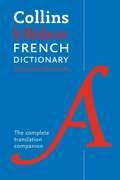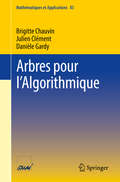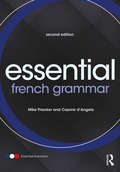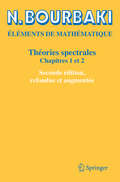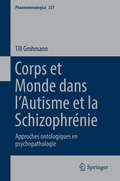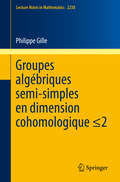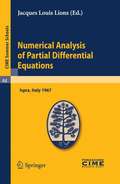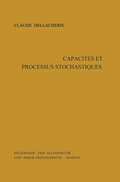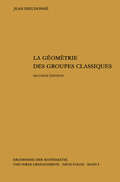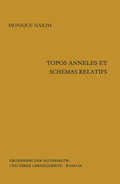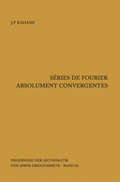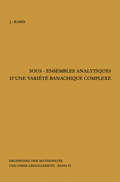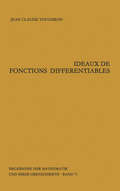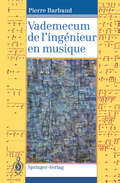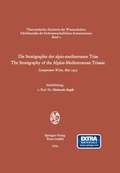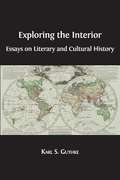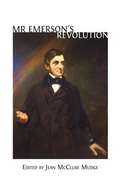- Table View
- List View
Collins Robert French Dictionary: The complete translation companion (PDF)
by Collins Dictionaries StaffThis French-English/English-French dictionary, is a collaboration between Collins and Le Robert, now revised and updated with hundreds of new words, phrases and senses. The supplements on communication, education systems and famous people of the French- and English-speaking worlds make this the perfect dictionary for use at college, home or work. Designed for students and professionals using French in the course of their work. Lexicographers draw on Collins' unique multi-million word databases of French and English to ensure that the user has the most complete and accurate picture of real language available today.
Arbres pour l’Algorithmique (Mathématiques et Applications #83)
by Danièle Gardy Julien Clément Brigitte ChauvinCet ouvrage présente les types d'arbres les plus utilisés en informatique, sous les angles algorithmique et mathématique. Pour chaque type, nous donnons les algorithmes courants associés et des exemples d'utilisation, directe ou en modélisation, puis nous étudions leurs performances d'un point de vue mathématique. Nos outils sont les mathématiques discrètes, les probabilités et la combinatoire analytique, présentés ici simultanément.Le public visé est d'abord celui des étudiants de niveau master scientifique ou en dernière année d’école d’ingénieurs avec un cursus préalable en informatique ou en mathématiques, ou ceux visant une double compétence en mathématiques et informatique ; ainsi que toute personne dotée d’un bagage scientifique « minimal » et amenée à utiliser des structures arborescentes liées à des algorithmes, qui souhaiterait avoir une meilleure connaissance de ces structures et une idée des performances des algorithmes associés sans se plonger dans les travaux originaux. This book presents a wide range of tree structures, from both a computer science and a mathematical point of view. For each of these structures we give the algorithms that allow us to visit or update the structure, and discuss their potential uses, either directly (for storing data) or in modelling a variety of situations. We present a mathematical approach to their performances; this is done by the systematic and parallel use of tools from discrete mathematics, probability and analytic combinatorics.The book is intended for graduate students in mathematics or computer science (or both) and in engineering schools. It is also suitable for anyone with a basic level of scientific knowledge who may have to use tree structures and related algorithms, and who wishes to get a rigorous knowledge of their performance without going back to the original, often specialized, results.
Essential French Grammar (Essential Language Grammars)
by Mike Thacker Casimir d'AngeloEssential French Grammar is a student-friendly French grammar designed to give learners a firm foundation on which to build a real understanding of both spoken and written French. Clear explanations of grammar are supported by contemporary examples, lively cartoon drawings and a variety of exercises. Key features of the second edition include: each grammar point explained initially with reference to English parallels between English and French provided where relevant 'Key points' box and tables that summarize grammar concepts real-life language examples in French, with English translations a variety of exercises to reinforce learning a contemporary primary source or literary extract to illustrate grammar in context more detailed coverage of punctuation, accents, spelling and the specific sounds of French This second edition includes an introductory chapter that describes the lexical and grammatical differences between French and English. A glossary of grammatical terms in French and English, useful verb tables, and a key to the exercises are also provided, making this an ideal resource for both independent and class-based learners. Essential French Grammar is an innovative reference grammar and workbook for intermediate and advanced undergraduate students of French. This text is ideal for students at CEFR levels B1 to C1, or Intermediate High to Advanced on the ACTFL scale.
Essential French Grammar (Essential Language Grammars)
by Mike Thacker Casimir d'AngeloEssential French Grammar is a student-friendly French grammar designed to give learners a firm foundation on which to build a real understanding of both spoken and written French. Clear explanations of grammar are supported by contemporary examples, lively cartoon drawings and a variety of exercises. Key features of the second edition include: each grammar point explained initially with reference to English parallels between English and French provided where relevant 'Key points' box and tables that summarize grammar concepts real-life language examples in French, with English translations a variety of exercises to reinforce learning a contemporary primary source or literary extract to illustrate grammar in context more detailed coverage of punctuation, accents, spelling and the specific sounds of French This second edition includes an introductory chapter that describes the lexical and grammatical differences between French and English. A glossary of grammatical terms in French and English, useful verb tables, and a key to the exercises are also provided, making this an ideal resource for both independent and class-based learners. Essential French Grammar is an innovative reference grammar and workbook for intermediate and advanced undergraduate students of French. This text is ideal for students at CEFR levels B1 to C1, or Intermediate High to Advanced on the ACTFL scale.
Théories spectrales: Chapitres 1 et 2
by N. BourbakiLes Éléments de mathématique de Nicolas BOURBAKI ont pour objet une présentation rigoureuse, systématique et sans prérequis des mathématiques depuis leurs fondements.Le Livre de Théories spectrales est consacré à l'étude des algèbres normées et de leurs applications. Le premier chapitre met en place la théorie fondamentale des algèbres de Banach et des algèbres stellaires. Nous y présentons l'équivalence de catégories entre algèbres stellaires commutatives et espaces topologiques localement compacts, ainsi que le calcul fonctionnel holomorphe en plusieurs variables dans une algèbre de Banach commutative. La transformation de Fourier, qui est l'un des outils mathématiques les plus universels, est étudiée au second chapitre, dans le cadre des groupes localement compacts commutatifs. Le texte est complété par de nombreux exercices. Ces deux chapitres forment une édition entièrement refondue de l'édition de 1967. The Elements of Mathematics of Nicolas Bourbaki have the goal of giving a rigorous and systematic presentation of mathematics starting from the foundations, without prerequisites. The book of Spectral Theories is devoted to the study of normed algebras and their applications. The first chapter establishes the basic theory of Banach algebras and C*-algebras. We present the equivalence of categories between commutative C*-algebras and locally compact topological spaces, as well as the holomorphic functional calculus in several variables in a commutative Banach algebra.The Fourier transform, which is one of the most universal mathematical tools, is studied in the second chapter, in the context of locally compact commutative topological groups.The text is accompanied by many exercices.These two chapters are completely updated new versions of the 1967 original edition.
Corps et Monde dans l’Autisme et la Schizophrénie: Approches ontologiques en psychopathologie (Phaenomenologica #227)
by Till GrohmannLe livre offre une investigation phénoménologique des traits caractéristiques des troubles du spectre de l'autisme et de la schizophrénie. Son matériel de base sont des écrits autobiographiques ainsi que des descriptions de patients en première personne. L’objectif principal de cette investigation est double: premièrement, de systématiquement élaborer la corrélation fondamentale entre le corps et le monde; deuxièmement, de comprendre autisme et schizophrénie comme des transformations typiques de cette corrélation. L’auteur interroge schizophrénie et autisme comme des transformations comparables, mais néanmoins fondamentalement distinctes, de la structure ambivalente du corps propre. Il combine une lecture de philosophie phénoménologique avec des approches provenant de la psychiatrie et de la psychopathologie. L’analyse phénoménologique de la corporéité amène l’auteur à analyser une double structure expérientielle, faite de vécus subjectifs et objectifs du corps. En référence à ce paradigme, autisme et schizophrénie apparaissent comme des possibles destins de la structure ambivalente du corps. Un rôle majeur est ici attribué à la spatialisation, c’est-à-dire aux différents modes de vivre et de représenter l’espace.
Groupes algébriques semi-simples en dimension cohomologique ≤2: Semisimple algebraic groups in cohomological dimension ≤2 (Lecture Notes in Mathematics #2238)
by Philippe GilleLa théorie des groupes algébriques sur un corps arbitraire est l’une des branches les plus merveilleuses des mathématiques modernes. Cette monographie porte sur les groupes algébriques semi-simples définis sur un corps k de dimension cohomologique séparable ≤2 et la cohomologie galoisienne d’iceux. La question ouverte la plus importante est la conjecture II de Serre (1962) qui prédit l’annulation de la cohomologie galoisienne d’un groupe semi-simple simplement connexe.Utilisant principalement des techniques de groupes algébriques, on couvre tous les cas connus de la conjecture: les cas classiques (dus à Bayer-Fluckiger and Parimala) ainsi que les avancées sur les cas exceptionnels restants (par exemple de type E8). Ceci s’applique à la classification des groupes semi-simples. The theory of algebraic groups over arbitrary fields is one of the most beautiful branches of modern mathematics. This monograph deals with semisimple algebraic groups over a general field k of separable cohomological dimension ^ to Bayer-Fluckiger and Parimala), and some perspectives are given on the remaining exceptional cases (e.g., G of type E8). Applications to the classification of semisimple k-groups are presented.
Numerical Analysis of Partial Differential Equations: Lectures given at a Summer School of the Centro Internazionale Matematico Estivo (C.I.M.E.) held in Ispra (Varese), Italy, July 3-11, 1967 (C.I.M.E. Summer Schools #44)
by Jacques-Louis LionsS. Albertoni: Alcuni metodi di calcolo nella teoria della diffusione dei neutroni.- I. Babuska: Optimization and numerical stability in computations.- J.H. Bramble: Error estimates in elliptic boundary value problems.- G. Capriz: The numerical approach to hydrodynamic problems.- A. Dou: Energy inequalities in an elastic cylinder.- T. Doupont: On the existence of an iterative method for the solution of elliptic difference equation with an improved work estimate.- J. Douglas, J.R. Cannon: The approximation of harmonic and parabolic functions of half-spaces from interior data.- B.E. Hubbard: Error estimates in the fixed Membrane problem.- K. Jorgens: Calculation of the spectrum of a Schrödinger operator.- A. Lasota: Contingent equations and boundary value problems.- J.L. Lions: Réduction à des problèmes du type Cauchy-Kowalewska.- J.L. Lions: Problèmes aux limites non homogènes à données irrégulières; une méthode d’approximation.- J.L. Lions: Remarques sur l’approximation régularisée de problèmes aux limites.- W.V. Petryshyn: On the approximation-solvability of nonlinear functional equations in normed linear spaces.- P.A. Raviart: Approximation des équations d’évolution par des méthodes variationnelles.- M. Sibony, H. Brezis: Méthodes d’approximation et d’itération pour les operateurs monotones.- V. Thomee: Some topics in stability theory for partial difference operators.
Capacités et processus stochastiques (Ergebnisse der Mathematik und ihrer Grenzgebiete. 2. Folge #67)
by Claude DellacherieThis book consists of two sections. The first section (A) is dealing with sets, capacities and measures of sets, giving elementary but deep theorems about approximation of measures and capacities for instance by compact sets. Besides concepts such as "paving capacity" and "capacibility" several modern and quite new concepts such as "capacitance", "mosaic", "envelope", and "scarper" ("rabotage") are introduces in order to describe refinements of the structure of classes of sets. Using these concepts the author proves in a new way know theorems such as Choquet's theorem in abstract form and he also gives new theorems for instance theorems about analytic sets. The second section (B) presents a general theory of stochastic processes but is mainly concerned with fundaments. It gives a far-reaching theory of stopping times and q-fields belonging to stopping times and classifications of stopping times and q-fields. This theory is then applied to stochastic processes, particularly to processes with realizations that are increasing functions. This book is well-fitted for researchers, who need a thorough knowledge of stochastic processes. H. Bergström.
La geometrie des groupes classiques: Reihe: Gruppentheorie (Ergebnisse der Mathematik und ihrer Grenzgebiete. 2. Folge #5)
by Jean DieudonneThis book gives an excellent survey of recent work on classical groups, simplifying and unifying the results of many authors. No attempt is made to cover all of the voluminous literature on classical groups; the author deals with only that portion of the subject which can be handled by the methods of linear algebra. By thus restricting his scope, he is able to include proofs of most of the results described, thereby making the book more self-contained than most Ergebnisse tracts.In the reviewer's opinion, this is an important and well-written book which should help to stimulate research on the classical groups. The book not only gives a thorough exposition of the present state of the subject, but is also an excellent introduction to the modern techniques basic to further work in this field.
Topos anneles et schemas relatifs (Ergebnisse der Mathematik und ihrer Grenzgebiete. 2. Folge #64)
by Monique HakimThis monograph is devoted to the problems of modules in scheme theory; the main purpose is to develop relative scheme theory over a ringed space. The exposition contains 8 chapters. Chapters I and II are devoted to the necessary information about 2-categories which simplifies the utilization of toposes. 2-category is a category in which the sets Hom are categories and where maps between Hom's have functorial nature. One studies U-toposes by means of this notion in chapter II, U being a fixed universimum. One introduces the notion of ringed U-toposand studies U-toposes ringed by local and strict local rings in chapter III. In the same chapter one solves the corresponding universal problem and as a result introduces the spectrum of ringed U-topos in chapter IV, what makes it possible to define the category of relative schemes over a ringed topos. In chapter V-VII the theory of relative S-schemes is developed where S is a ringed topos; then this theory applies to studying of the algebraic-analytic equivalence in chapter VIII. A. A. Bel'skii.
Séries de Fourier absolument convergentes (Ergebnisse der Mathematik und ihrer Grenzgebiete. 2. Folge #50)
by Jean-Pierre KahaneThis book surveys an important and rapidly growing area of harmonic analysis, the theory of the algebra A(T) of functions f on the group T with absolutely convergent Fourier series. It includes chapters about Fourier series of continuous functions, descriptive theory, pseudomeasures and classes A(E), closed ideals, composed functions, thin sets and Baire methods, tensor algebras and applications, isomorphism of algebras A(E) and lacunary series. A striking feature of the book is its genuine classical flavor. The author is thoroughly at home with computations of many kinds, and every chapter has a wealth of specific examples and constructions. In sum, the book is an admirable survey of its topic. It is a highly interesting and useful work for Fourier analysists.
Sous-ensembles analytiques d'une variete banachique complexe (Ergebnisse der Mathematik und ihrer Grenzgebiete. 2. Folge #53)
by Jean-Pierre RamisThis book gives an exposition of A. Douady's works in the theory of Banach analytic varieties.
Ideaux de fonctions différentiables (Ergebnisse der Mathematik und ihrer Grenzgebiete. 2. Folge #71)
by Jean-Claude TougeronThis book contains background materials and recent results in the study of germs of C∞ and real analytic functions.
Vademecum de l'ingénieur en musique
by Pierre BarbaudPresenter les fondements et les evolutions de la musique occidentale, d'une maniere nouvelle car completement rationnelle, voila le but premier du "Vademecum". Une fois mise au point la codification, originale, de tous les concepts musicaux, Pierre Barbaud peut alors proposer des methodes de composition avec un ordinateur. Le livre evite, la plupart du temps, toute secheresse grace a de nombreux exemples et a un style ou l'humour et les references litteraires sont frequents. Un chercheur en informatique,un musicien ayant quelques notions scientifiques, ou meme toute personne interessee par le sujet, sans pour autant posseder de connaissances techniques approfondies, trouveront donc dans le "Vademecum de l'Ingenieur en Musique" les principes generaux leur permettant de composer de la musique automatiquement, quel que soit le moyen de productiondu son.
Die Stratigraphie der alpin-mediterranen Trias / The Stratigraphy of the Alpine-Mediterranean Triassic: Symposium Wien, Mai 1973 (Schriftenreihe der Erdwissenschaftlichen Kommission #2)
by Helmuth ZapfeOrganisiert im Hinblick auf das Internationale Geologische Korrelationsprogramm (IGCP)
Life Histories of Etnos Theory in Russia and Beyond
by David G. Anderson Dmitry V. Arzyutov Sergei S. AlymovThe idea of etnos came into being over a hundred years ago as a way of understanding the collective identities of people with a common language and shared traditions. In the twentieth century, the concept came to be associated with Soviet state-building, and it fell sharply out of favour. Yet outside the academy, etnos-style arguments not only persist, but are a vibrant part of regional anthropological traditions. Life Histories of Etnos Theory in Russia and Beyond makes a powerful argument for reconsidering the importance of etnos in our understanding of ethnicity and national identity across Eurasia. The collection brings to life a rich archive of previously unpublished letters, fieldnotes, and photographic collections of the theory’s early proponents. Using contemporary fieldwork and case studies, the volume shows how the ideas of these ethnographers continue to impact and shape identities in various regional theatres from Ukraine to the Russian North to the Manchurian steppes of what is now China. Through writing a life history of these collectivist concepts, the contributors to this volume unveil a world where the assumptions of liberal individualism do not hold. In doing so, they demonstrate how notions of belonging are not fleeting but persistent, multi-generational, and bio-social.
Beyond Holy Russia: The Life And Times Of Stephen Graham
by Michael HughesThis biography of the travel writer and novelist Stephen Graham is learned, elegantly written and an original and important contribution to the scholarly literature on Anglo-Russian cultural relations, while also maintaining strong appeal for the general reader. [...] 'Beyond Holy Russia' provides a full and deeply considered account of the long and prolific life of Stephen Graham, alive to all its cultural, political and personal paradoxes. At the same time, it gives a rich portrait of English, Russian and American literary life in the first half of the twentieth century and beyond. — Rachel Polonsky This biography examines the long life of the traveller and author Stephen Graham. Graham walked across large parts of the Tsarist Empire in the years before 1917, describing his adventures in a series of books and articles that helped to shape attitudes towards Russia in Britain and the United States. In later years he travelled widely across Europe and North America, meeting some of the best known writers of the twentieth century, including H.G.Wells and Ernest Hemingway. Graham also wrote numerous novels and biographies that won him a wide readership on both sides of the Atlantic. This book traces Graham’s career as a world traveller, and provides a rich portrait of English, Russian and American literary life in the first half of the twentieth century. It also examines how many aspects of his life and writing coincide with contemporary concerns, including the development of New Age spirituality and the rise of environmental awareness. Beyond Holy Russia is based on extensive research in archives of private papers in Britain and the USA and on the many works of Graham himself. The author describes with admirable tact and clarity Graham’s heterodox and convoluted spiritual quest. The result is a fascinating portrait of a man who was for many years a significant literary figure on both sides of the Atlantic.
The Classic Short Story, 1870-1925: Theory Of A Genre
by Florence GoyetThe ability to construct a nuanced narrative or complex character in the constrained form of the short story has sometimes been seen as the ultimate test of an author's creativity. Yet during the time when the short story was at its most popular—the late nineteenth and early twentieth centuries—even the greatest writers followed strict generic conventions that were far from subtle. This expanded and updated translation of Florence Goyet's influential La Nouvelle, 1870-1925: Description d'un genre à son apogée (Paris, 1993) is the only study to focus exclusively on this classic period across different continents. Ranging through French, English, Italian, Russian and Japanese writing—particularly the stories of Guy de Maupassant, Henry James, Giovanni Verga, Anton Chekhov and Akutagawa Ryunosuke—Goyet shows that these authors were able to create brilliant and successful short stories using the very simple 'tools of brevity' of that period. In this challenging and far-reaching study, Goyet looks at classic short stories in the context in which they were read at the time: cheap newspapers and higher-end periodicals. She demonstrates that, despite the apparent intention of these stories to question bourgeois ideals, they mostly affirmed the prejudices of their readers. In doing so, her book forces us to re-think our preconceptions about this 'forgotten' genre.
Die Europaidee im Zeitalter der Aufklärung
by Rotraud von Kulessa und Catriona SethAngesichts der aktuellen Herausforderungen – nicht zuletzt politischer Natur – mit denen sich viele europäische Staaten konfrontiert sehen, haben sich die Aufklärungsforscher entschlossen, auf die Geschichte der Europaidee zurückzukommen. Bereits im 18. Jahrhundert und zuvor besann man sich auf gemeinsame Werte und eine gemeinsame Geschichte; die damals gestellten Fragen ähneln in vielen Bereichen den heutigen. Die Autoren und Philosophen der Aufklärung haben so bereits über die Möglichkeiten einer europäischen Einigung zwecks Sicherung des Friedens auf dem Kontinent nachgedacht. Die Texte der vorliegenden Anthologie, verfasst sowohl von den großen Denkern der Zeit (Rousseau, Montesquieu, Voltaire, Kant, Hume oder Germaine de Staël) wie auch von weniger bekannten oder gar in Vergessenheit geratenen, präsentieren, mit einigen chronologischen Exkursen (von Sully bis Victor Hugo), die Ideen der Denker eines weit gefassten 18. Jahrhunderts zu Europa, seiner Geschichte, seiner Vielfalt, aber auch zu den Gemeinsamkeiten der Nationen, die trotz ihrer Vielfalt eine geographische Einheit bilden. Die Texte zeigen uns so die historischen Ursprünge des Projektes der europäischen Einigung, erörtern die Vorteile einer assoziierten Türkei und einer Einbindung des Maghreb sowie die Bedeutung des europäischen Handels. Sie verweisen auch auf die durch die historischen Unruhen verursachten Ängste wie auch auf die Zukunftsperspektiven eines vereinten Europas. Das Buch wurde mit Unterstützung der Universitäten Augsburg, Oxford sowie der Société française d’étude du XVIIIe siècle gedruckt. In view of the challenges—many of which are political—that different European countries are currently facing, scholars who work on the 18th century have compiled this anthology which includes earlier recognitions of common values and past considerations of questions which often remain pertinent nowadays. During the Enlightenment, many men and women of letters envisaged the continent’s future in particular when stressing their hope that peace could be secured in Europe. The texts gathered here, and signed by major thinkers of the time (Rousseau, Montesquieu, Voltaire, Kant, Hume or Staël for instance), as well as by writers history has forgotten, present the reflections, with a couple of chronological extensions (from Sully to Victor Hugo) of authors from the long eighteenth century—the French Empire and the fall of Napoleon generated numerous upheavals—on Europe, its history, its diversity, but also on what the nations, which, in all their diversity, make up a geographical unit, have in common. They show the historical origins of the project of a European union, the desire to consolidate the continent’s ties to the Maghreb or to Turkey, the importance granted to commerce and the worries engendered by history’s convulsions, but also the hope vested in future generations. The Société française d’étude du XVIIIe siècle, Augsburg University and the University of Oxford have generously contributed towards the publication of this volume.
L’idée de l’Europe au Siècle des Lumières
by Rotraud Von Kulessa Et Catriona SethFace aux défis – entre autres politiques – auxquels sont confrontés différents pays européens, les chercheurs dix-huitiémistes ont souhaité revenir sur des expressions anciennes de valeurs partagées et les interrogations passées sur des questions qui restent souvent d’actualité. Au Siècle des Lumières, nombre d’hommes et de femmes de lettres ont envisagé l’avenir du continent en particulier pour entériner leur souhait de garantir la paix en Europe. Les textes, réunis dans cette anthologie, et signés des grands écrivains du temps (Rousseau, Montesquieu, Voltaire, Kant, Hume ou encore Staël), comme d’oubliés de l’histoire, présentent, avec quelques excursus chronologiques (de Sully à Hugo) les réflexions de penseurs d’un dix-huitième siècle aux bornes chronologiques étendues – l’émergence et la chute de l’Empire engendrent des bouleversements nombreux –, sur l’Europe, son histoire, sa diversité, mais aussi sur ce qu’ont en commun les nations qui composent, dans leur variété, un ensemble géographique. Ils mettent en évidence les origines historiques d’un projet d’union européenne, le souhait de consolider les liens du continent avec le Maghreb ou la Turquie, l’importance accordée au commerce et les inquiétudes suscitées par les sursauts de l’histoire, mais aussi l’espoir placé dans les générations futures. La Société française d’étude du XVIIIe siècle, l’Université d’Augsburg, l’Université d’Oxford ont généreusement contribué à la publication de ce volume. In view of the challenges—many of which are political—that different European countries are currently facing, scholars who work on the 18th century have compiled this anthology which includes earlier recognitions of common values and past considerations of questions which often remain pertinent nowadays. During the Enlightenment, many men and women of letters envisaged the continent’s future in particular when stressing their hope that peace could be secured in Europe. The texts gathered here, and signed by major thinkers of the time (Rousseau, Montesquieu, Voltaire, Kant, Hume or Staël for instance), as well as by writers history has forgotten, present the reflections, with a couple of chronological extensions (from Sully to Victor Hugo) of authors from the long eighteenth century—the French Empire and the fall of Napoleon generated numerous upheavals—on Europe, its history, its diversity, but also on what the nations, which, in all their diversity, make up a geographical unit, have in common. They show the historical origins of the project of a European union, the desire to consolidate the continent’s ties to the Maghreb or to Turkey, the importance granted to commerce and the worries engendered by history’s convulsions, but also the hope vested in future generations. The Société française d’étude du XVIIIe siècle, Augsburg University and the University of Oxford have generously contributed towards the publication of this volume.
Exploring the Interior: Essays On Literary And Cultural History
by Karl S. GuthkeIn this fascinating collection of essays Harvard Emeritus Professor Karl S. Guthke examines the ways in which, for European scholars and writers of the eighteenth and early nineteenth century, world-wide geographical exploration led to an exploration of the self. Guthke explains how in the age of Enlightenment and beyond intellectual developments were fuelled by excitement about what Ulrich Im Hof called "the grand opening-up of the wide world”, especially of the interior of the non-European continents. This outward turn was complemented by a fascination with "the world within” as anthropology and ethnology focused on the humanity of the indigenous populations of far-away lands – an interest in human nature that suggested a way for Europeans to understand themselves, encapsulated in Gauguin’s Tahitian rumination "What are we?” The essays in the first half of the book discuss first- or second-hand, physical or mental encounters with the exotic lands and populations beyond the supposed cradle of civilisation. The works of literature and documents of cultural life featured in these essays bear testimony to the crossing not only of geographical, ethnological, and cultural borders but also of borders of a variety of intellectual activities and interests. The second section examines the growing interest in astronomy and the engagement with imagined worlds in the universe, again with a view to understanding homo sapiens, as compared now to the extra-terrestrials that were confidently assumed to exist. The final group of essays focuses on the exploration of the landscape of what was called "the universe within”; featuring, among a variety of other texts, Schiller’s plays The Maid of Orleans and William Tell, these essays observe and analyse what Erich Heller termed "The Artist’s Journey into the Interior.” This collection, which travels from the interior of continents to the interior of the mind, is itself a set of explorations that revel in the discovery of what was half-hidden in language. Written by a scholar of international repute, it is eye-opening reading for all those with an interest in the literary and cultural history of (and since) the Enlightenment.
Human and Machine Consciousness
by David GamezConsciousness is widely perceived as one of the most fundamental, interesting and difficult problems of our time. However, we still know next to nothing about the relationship between consciousness and the brain and we can only speculate about the consciousness of animals and machines. Human and Machine Consciousness presents a new foundation for the scientific study of consciousness. It sets out a bold interpretation of consciousness that neutralizes the philosophical problems and explains how we can make scientific predictions about the consciousness of animals, brain-damaged patients and machines. Gamez interprets the scientific study of consciousness as a search for mathematical theories that map between measurements of consciousness and measurements of the physical world. We can use artificial intelligence to discover these theories and they could make accurate predictions about the consciousness of humans, animals and artificial systems. Human and Machine Consciousness also provides original insights into unusual conscious experiences, such as hallucinations, religious experiences and out-of-body states, and demonstrates how ‘designer’ states of consciousness could be created in the future. Gamez explains difficult concepts in a clear way that closely engages with scientific research. His punchy, concise prose is packed with vivid examples, making it suitable for the educated general reader as well as philosophers and scientists. Problems are brought to life in colourful illustrations and a helpful summary is given at the end of each chapter. The endnotes provide detailed discussions of individual points and full references to the scientific and philosophical literature.
The Idea of Europe: Enlightenment Perspectives (Open Book Classics Ser. #Vol. 7)
by Catriona Seth Rotraud Von KulessaIn view of the challenges—many of which are political—that different European countries are currently facing, scholars who work on the eighteenth century have compiled this anthology which includes earlier recognitions of common values and past considerations of questions which often remain pertinent nowadays. During the Enlightenment, many men and women of letters envisaged the continent’s future in particular when stressing their hope that peace could be secured in Europe. The texts gathered here, and signed by major thinkers of the time (Rousseau, Montesquieu, Voltaire, Kant, Hume or Staël for instance), as well as by writers history has forgotten, present the reflections, with a couple of chronological extensions (from Sully to Victor Hugo) of authors from the long eighteenth century—the French Empire and the fall of Napoleon generated numerous upheavals—on Europe, its history, its diversity, but also on what the nations, which, in all their diversity, make up a geographical unit, have in common. They show the historical origins of the project of a European union, the desire to consolidate the continent’s ties to the Maghreb or to Turkey, the importance granted to commerce and the worries engendered by history’s convulsions, but also the hope vested in future generations. The Idea of Europe follows its sister edition in French, L’idée de l’Europe au Siècle des Lumières, also published by Open Book. The Société française d’étude du XVIIIe siècle, Augsburg University and the University of Oxford have generously contributed towards the publication of this volume.
Mr. Emerson's Revolution
by Jean McClure MudgeThis volume traces the life, thought and work of Ralph Waldo Emerson, a giant of American intellectual history, whose transforming ideas greatly strengthened the two leading reform issues of his day: abolition and women’s rights. A broad and deep, yet cautious revolutionary, he spoke about a spectrum of inner and outer realities—personal, philosophical, theological and cultural—all of which gave his mid-career turn to political and social issues their immediate and lasting power. This multi-authored study frankly explores Emerson's private prejudices against blacks and women while he also publicly championed their causes. Such a juxtaposition freshly charts the evolution of Emerson's slow but steady application of his early neo-idealism to emancipating blacks and freeing women from social bondage. His shift from philosopher to active reformer had lasting effects not only in America but also abroad. In the U.S. Emerson influenced such diverse figures as Thoreau, Whitman, Dickinson and William James and in Europe Mickiewicz, Wilde, Kipling, Nietzsche, and Camus in Europe as well as many leading followers in India and Japan. The book includes over 170 illustrations, among them eight custom-made maps of Emerson's haunts and wide-ranging lecture itineraries as well as a new four-part chronology of his life placed alongside both national and international events as well as major inventions. Mr. Emerson's Revolution provides essential reading for students and teachers of American intellectual history, the abolitionist and women’s rights movement―and for anyone interested in the nineteenth-century roots of these seismic social changes.
